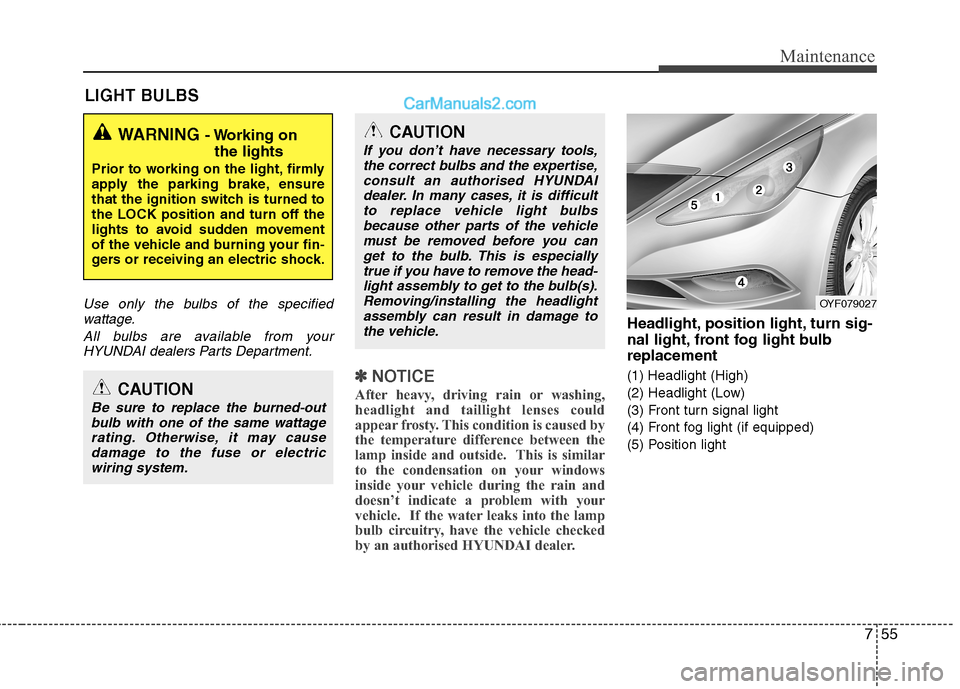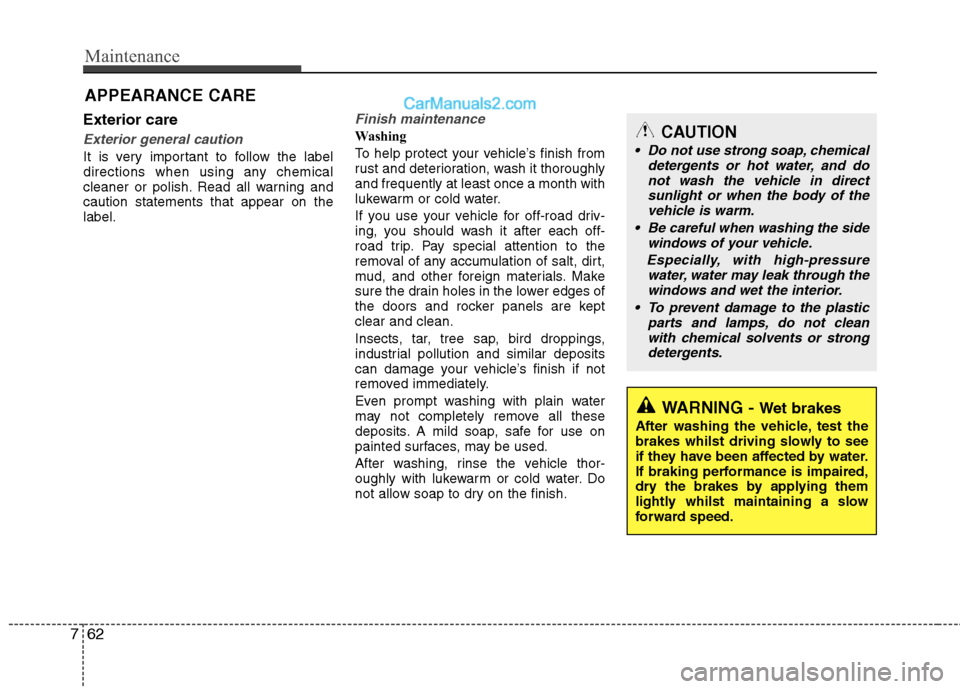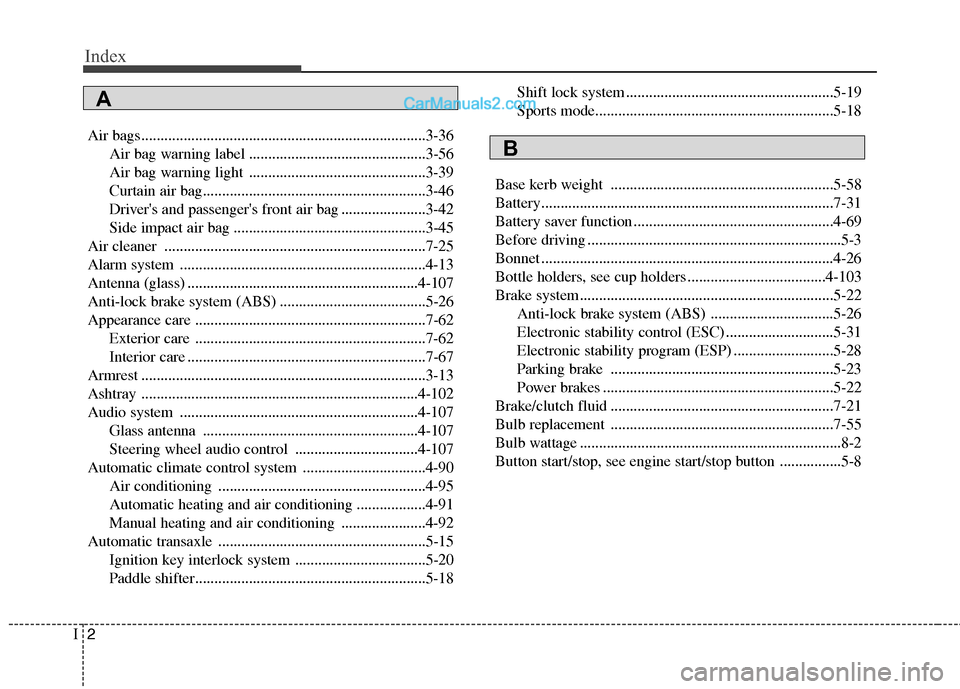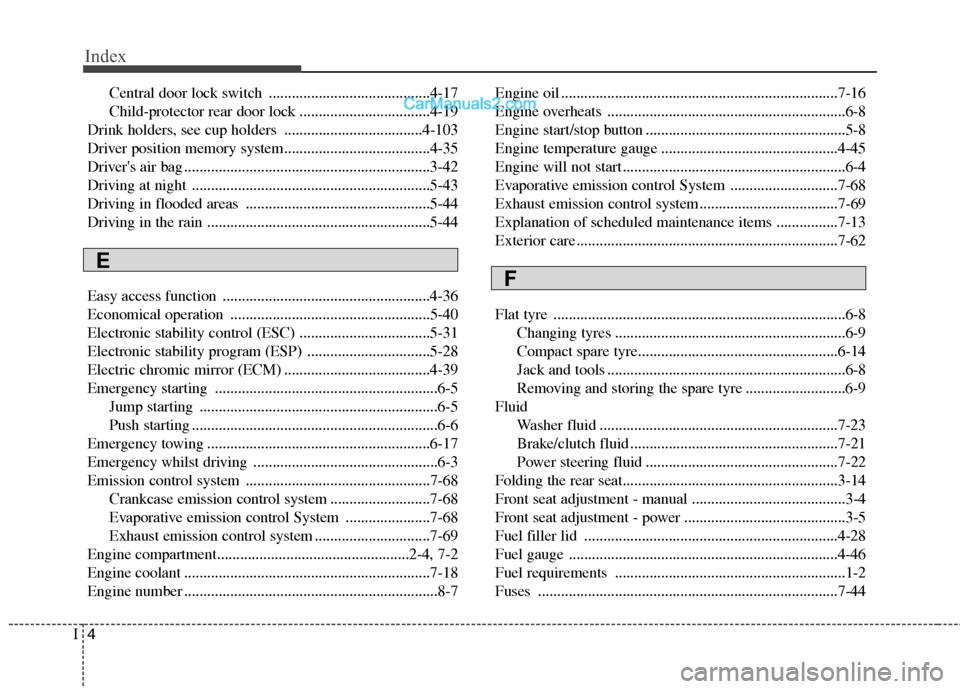2012 Hyundai Sonata ESP
[x] Cancel search: ESPPage 331 of 363

755
Maintenance
LIGHT BULBS
Use only the bulbs of the specifiedwattage.
All bulbs are available from yourHYUNDAI dealers Parts Department.
✽✽ NOTICE
After heavy, driving rain or washing,
headlight and taillight lenses could
appear frosty. This condition is caused by
the temperature difference between the
lamp inside and outside. This is similar
to the condensation on your windows
inside your vehicle during the rain and
doesn’t indicate a problem with your
vehicle. If the water leaks into the lamp
bulb circuitry, have the vehicle checked
by an authorised HYUNDAI dealer.
Headlight, position light, turn sig-
nal light, front fog light bulbreplacement
(1) Headlight (High)
(2) Headlight (Low)
(3) Front turn signal light
(4) Front fog light (if equipped)
(5) Position light
WARNING - Working on
the lights
Prior to working on the light, firmly
apply the parking brake, ensure
that the ignition switch is turned tothe LOCK position and turn off the
lights to avoid sudden movement
of the vehicle and burning your fin-
gers or receiving an electric shock.
CAUTION
Be sure to replace the burned-out bulb with one of the same wattagerating. Otherwise, it may causedamage to the fuse or electricwiring system.
CAUTION
If you don’t have necessary tools,the correct bulbs and the expertise,
consult an authorised HYUNDAIdealer. In many cases, it is difficultto replace vehicle light bulbs because other parts of the vehicle
must be removed before you canget to the bulb. This is especiallytrue if you have to remove the head-
light assembly to get to the bulb(s).Removing/installing the headlightassembly can result in damage tothe vehicle.
OYF079027
Page 338 of 363

Maintenance
62
7
Exterior care
Exterior general caution
It is very important to follow the label
directions when using any chemical
cleaner or polish. Read all warning andcaution statements that appear on thelabel.
Finish maintenance
Washing
To help protect your vehicle’s finish from
rust and deterioration, wash it thoroughlyand frequently at least once a month with
lukewarm or cold water.
If you use your vehicle for off-road driv-
ing, you should wash it after each off-
road trip. Pay special attention to the
removal of any accumulation of salt, dirt,
mud, and other foreign materials. Make
sure the drain holes in the lower edges of
the doors and rocker panels are keptclear and clean.
Insects, tar, tree sap, bird droppings,
industrial pollution and similar deposits
can damage your vehicle’s finish if not
removed immediately.
Even prompt washing with plain water
may not completely remove all these
deposits. A mild soap, safe for use on
painted surfaces, may be used.
After washing, rinse the vehicle thor-
oughly with lukewarm or cold water. Do
not allow soap to dry on the finish.
APPEARANCE CARECAUTION
Do not use strong soap, chemical
detergents or hot water, and do
not wash the vehicle in direct sunlight or when the body of thevehicle is warm.
Be careful when washing the side windows of your vehicle.
Especially, with high-pressure water, water may leak through thewindows and wet the interior.
To prevent damage to the plastic parts and lamps, do not clean
with chemical solvents or strongdetergents.
WARNING - Wet brakes
After washing the vehicle, test the
brakes whilst driving slowly to see
if they have been affected by water.
If braking performance is impaired,
dry the brakes by applying them
lightly whilst maintaining a slow
forward speed.
Page 344 of 363

Maintenance
68
7
EMISSION CONTROL SYSTEM (IF EQUIPPED)
The emission control system of your
vehicle is covered by a written limited
warranty. Please see the warranty infor-
mation contained in the Service Passport
in your vehicle.
Your vehicle is equipped with an emis-
sion control system to meet all Australian
Design Rules (ADR) requirements. There are three emission control sys-
tems, as follows.
(1) Crankcase emission control system
(2) Evaporative emission control system(3) Exhaust emission control system In order to assure the proper function of
the emission control systems, it is rec-
ommended that you have your car
inspected and maintained by an autho-
rised HYUNDAI dealer in accordancewith the maintenance schedule in this
manual. Caution for the Inspection and
Maintenance Test (With Electronic
Stability Program (ESP) or Electronic
Stability Control (ESC) system)
To prevent the vehicle from misfiring
during dynamometer testing, turn
the Electronic Stability Program
(ESP) or Electronic Stability Control
(ESC) system off by pressing the
ESP (or ESC) switch.
After dynamometer testing is com- pleted, turn the ESP (or ESC) sys-
tem back on by pressing the ESP (or
ESC) switch again. 1. Crankcase emission control
system
The positive crankcase ventilation sys-
tem is employed to prevent air pollution
caused by blow-by gases being emitted
from the crankcase. This system supplies
fresh filtered air to the crankcase through
the air intake hose. Inside the crankcase,
the fresh air mixes with blow-by gases,
which then pass through the PCV valveinto the induction system.
2. Evaporative emission control system
The Evaporative Emission Control
System is designed to prevent fuel
vapours from escaping into the atmos-
phere.
Page 351 of 363

85
Specifications & Consumer information
Recommended SAE viscosity
number Engine oil viscosity (thickness) has an
effect on fuel economy and cold weather
operating (engine start and engine oil
flowability). Lower viscosity engine oils
can provide better fuel economy and cold
weather performance, however, higher
viscosity engine oils are required for sat-
isfactory lubrication in hot weather. Using
oils of any viscosity other than those rec-ommended could result in engine dam-
age.When choosing an oil, consider the range
of temperature your vehicle will be oper-
ated in before the next oil change.Proceed to select the recommended oil
viscosity from the chart.
CAUTION
Always be sure to clean the area
around any filler plug, drain plug, ordipstick before checking or drain-ing any lubricant. This is especially
important in dusty or sandy areasand when the vehicle is used onunpaved roads. Cleaning the plugand dipstick areas will prevent dirt
and grit from entering the engine and other mechanisms that couldbe damaged.
Temperature Range for SAE Viscosity Numbers
Temperature
Petrol
Engine Oil * 1°C
(°F)-30 -20 -10 0 10 20 30 40 50 -10 0 20 40 60 80 100 120
*1. For better fuel economy, it is recommended to use the engine oil of a viscosity grade SAE5W-20 (API SM / ILSAC GF-4). However, if the engine oil is not available in your country,
select the proper engine oil using the engine oil viscosity chart.
20W-50
10W-30
15W-40
5W-20, 5W-30
Page 355 of 363

Index
2
I
Air bags..........................................................................3-36
Air bag warning label ..............................................3-56
Air bag warning light ..............................................3-39
Curtain air bag..........................................................3-46
Driver's and passenger's front air bag ......................3-42
Side impact air bag ..................................................3-45
Air cleaner ....................................................................7-25
Alarm system ................................................................4-13
Antenna (glass) ............................................................4-107
Anti-lock brake system (ABS) ......................................5-26
Appearance care ............................................................7-62 Exterior care ............................................................7-62
Interior care ..............................................................7-67
Armrest ..........................................................................3-13
Ashtray ........................................................................4-102
Audio system ..............................................................4-107 Glass antenna ........................................................4-107
Steering wheel audio control ................................4-107
Automatic climate control system ................................4-90 Air conditioning ......................................................4-95
Automatic heating and air conditioning ..................4-91
Manual heating and air conditioning ......................4-92
Automatic transaxle ......................................................5-15 Ignition key interlock system ..................................5-20
Paddle shifter............................................................5-18 Shift lock system ......................................................5-19
Sports mode..............................................................5-18
Base kerb weight ..........................................................5-58
Battery............................................................................7-31
Battery saver function ....................................................4-69
Before driving ..................................................................5-3
Bonnet ............................................................................4-26
Bottle holders, see cup holders ....................................4-103
Brake system..................................................................5-22 Anti-lock brake system (ABS) ................................5-26
Electronic stability control (ESC) ............................5-31
Electronic stability program (ESP) ..........................5-28
Parking brake ..........................................................5-23
Power brakes ............................................................5-22
Brake/clutch fluid ..........................................................7-21
Bulb replacement ..........................................................7-55
Bulb wattage ....................................................................8-2
Button start/stop, see engine start/stop button ................5-8
A
B
Page 357 of 363

Index
4
I
Central door lock switch ..........................................4-17
Child-protector rear door lock ..................................4-19
Drink holders, see cup holders ....................................4-103
Driver position memory system......................................4-35
Driver's air bag ................................................................3-42
Driving at night ..............................................................5-43
Driving in flooded areas ................................................5-44
Driving in the rain ..........................................................5-44
Easy access function ......................................................4-36
Economical operation ....................................................5-40
Electronic stability control (ESC) ..................................5-31
Electronic stability program (ESP) ................................5-28
Electric chromic mirror (ECM) ......................................4-39
Emergency starting ..........................................................6-5 Jump starting ..............................................................6-5
Push starting ................................................................6-6
Emergency towing ..........................................................6-17
Emergency whilst driving ................................................6-3
Emission control system ................................................7-68 Crankcase emission control system ..........................7-68
Evaporative emission control System ......................7-68
Exhaust emission control system ..............................7-69
Engine compartment..................................................2-4, 7-2
Engine coolant ................................................................7-18
Engine number ..................................................................8-7 Engine oil ........................................................................7-16
Engine overheats ..............................................................6-8
Engine start/stop button ....................................................5-8
Engine temperature gauge ..............................................4-45
Engine will not start..........................................................6-4
Evaporative emission control System ............................7-68
Exhaust emission control system ....................................7-69
Explanation of scheduled maintenance items ................7-13
Exterior care....................................................................7-62
Flat tyre ............................................................................6-8
Changing tyres ............................................................6-9
Compact spare tyre....................................................6-14
Jack and tools ..............................................................6-8
Removing and storing the spare tyre ..........................6-9
Fluid Washer fluid ..............................................................7-23
Brake/clutch fluid ......................................................7-21
Power steering fluid ..................................................7-22
Folding the rear seat........................................................3-14
Front seat adjustment - manual ........................................3-4
Front seat adjustment - power ..........................................3-5
Fuel filler lid ..................................................................4-28
Fuel gauge ......................................................................4-46
Fuel requirements ............................................................1-2
Fuses ..............................................................................7-44
F
E